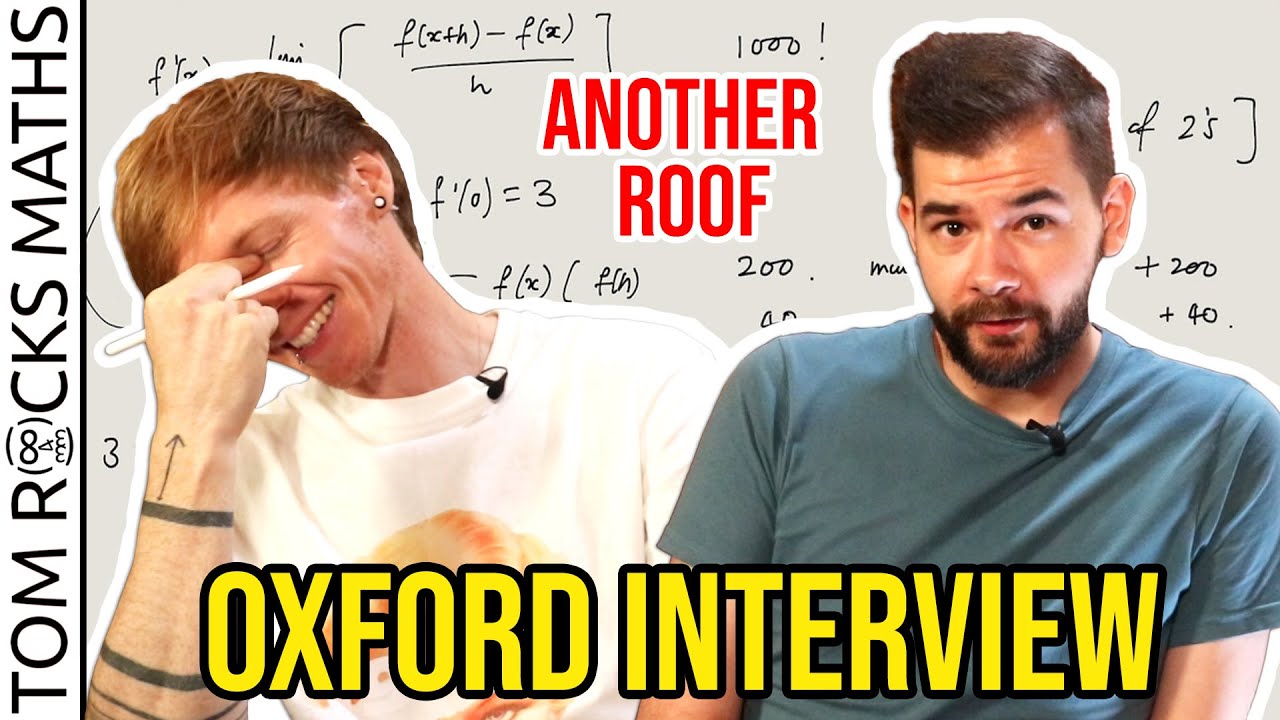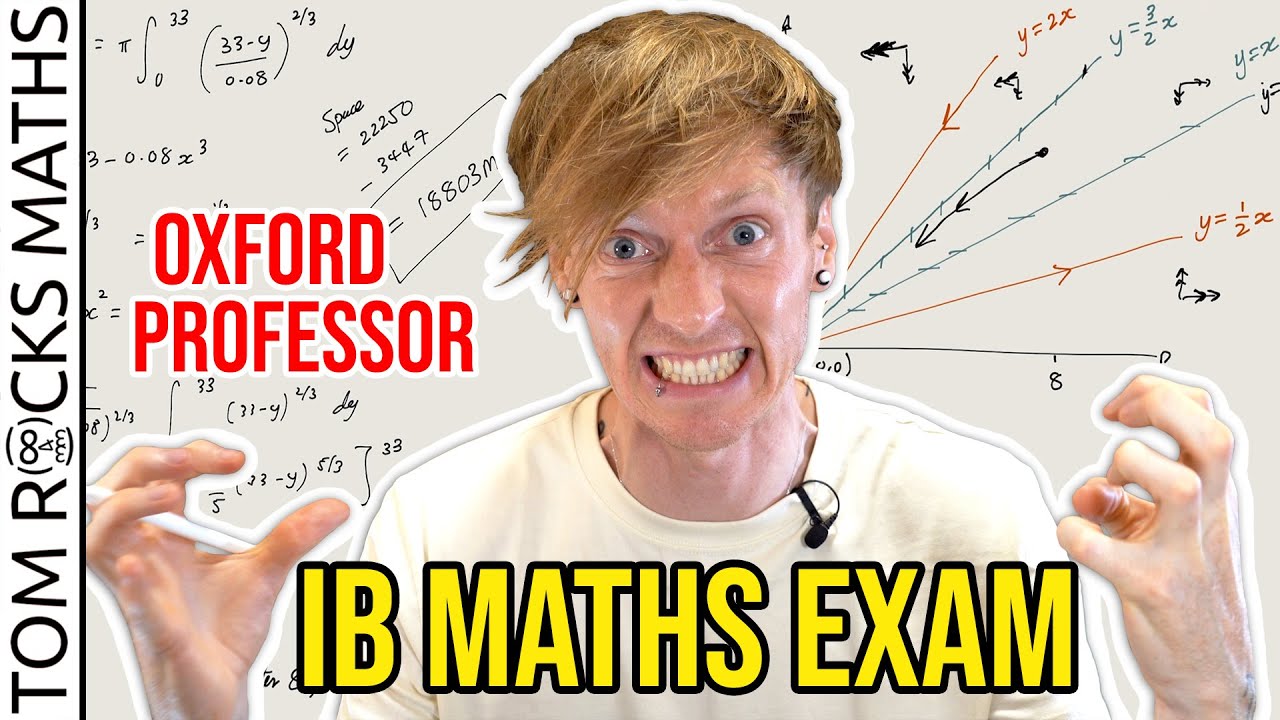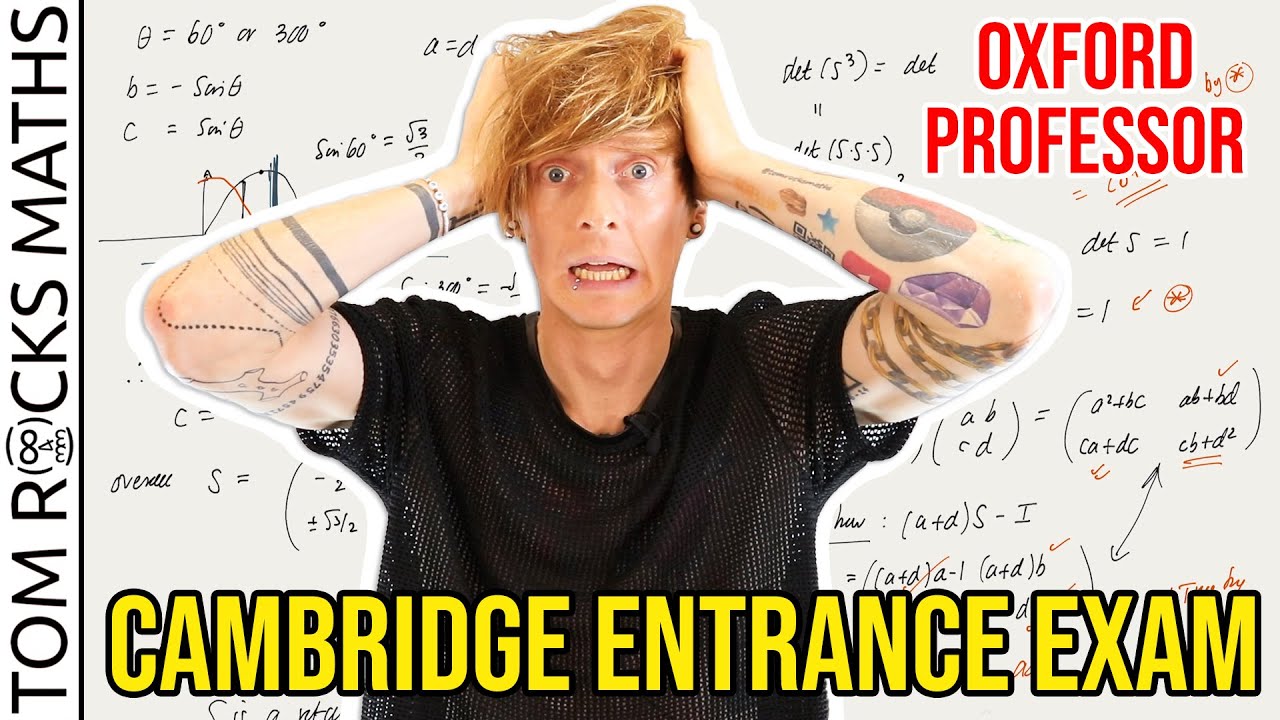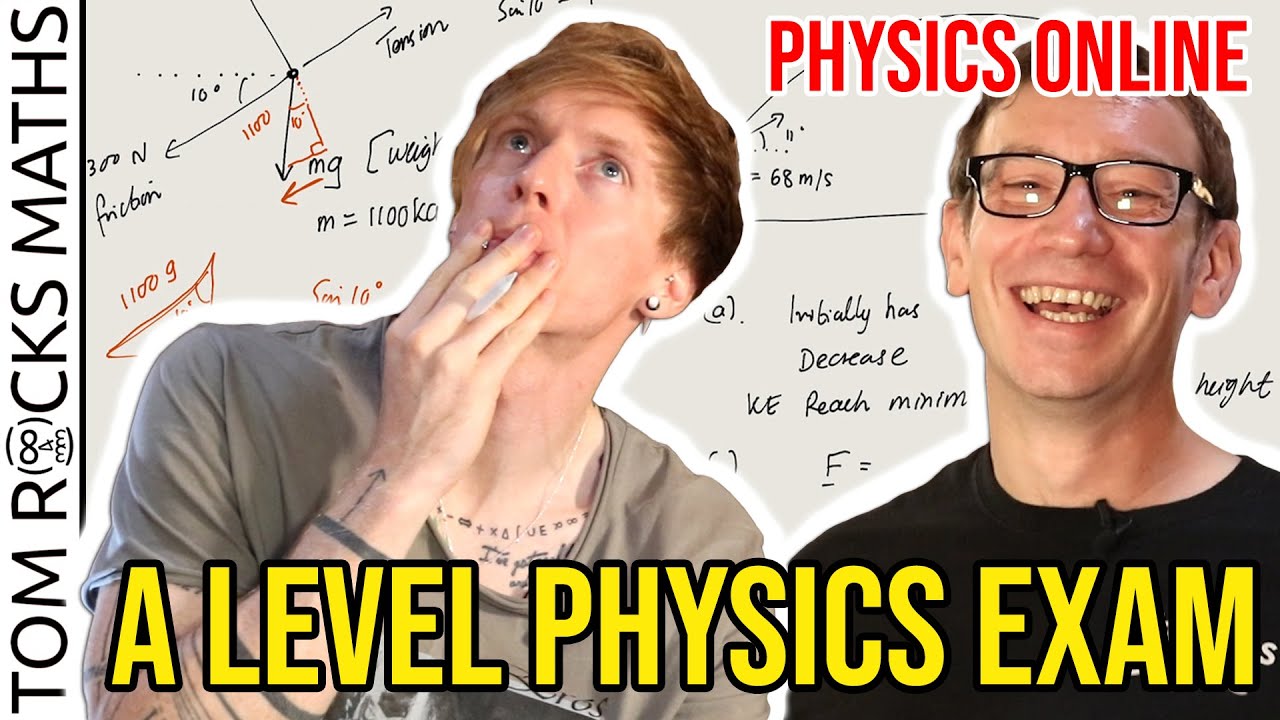How Hard is an Oxford Maths Interview? Feat. Tom Rocks Maths
TLDRIn this engaging video transcript, Alex, a mathematician and YouTuber, gets a unique opportunity to experience an Oxford interview with Dr. Tom Crawford, a mathematician from the University of Oxford. Despite having missed out on an interview in his youth, Alex dives into a series of mathematical problems designed to be both challenging and enjoyable. The session covers a range of topics from functions to probability, with a special focus on the Riemann zeta function and its intriguing connection to prime numbers, leading to a discussion on the Euler product formula. Throughout the interview, Dr. Crawford provides a collaborative and supportive environment, countering the stereotype of a stern academic atmosphere. Alex appreciates the experience, finding it both enlightening and reassuring, and the transcript offers viewers a glimpse into the world of Oxford interviews, emphasizing the importance of intuition and problem-solving in mathematics.
Takeaways
- 📚 The speaker, Alex, shares his experience of not getting an interview at the University of Oxford despite applying, which was a significant moment in his academic journey.
- 🤔 Dr. Tom Crawford, a mathematician from the University of Oxford, helps Alex experience what an Oxford interview is like, providing insight into the admissions process.
- 🏛 The interview process at Oxford is described as the final stage after application and an admissions test, where a selected group of students are invited for an in-person interview.
- 🧐 Alex is given a mathematical problem to solve as part of the interview, which is an implicitly defined function problem, aiming to assess his mathematical thinking and problem-solving skills.
- 🎓 Dr. Crawford emphasizes that the interview is collaborative, not intended to trick or embarrass the candidate, but to work through interesting problems together.
- 💡 The video includes thought bubbles to share Alex's thought process, showing both his struggles and successes in solving the problems, offering a transparent look at the problem-solving process.
- 🧮 A probability question related to the Riemann zeta function is also discussed, which is a complex topic made accessible through the interview format.
- 🔢 The concept of independence of events and its application in calculating the probability of simultaneous occurrences is explored, leading to a satisfying mathematical conclusion.
- 📉 The interview touches on Euler's product formula, an advanced mathematical concept, demonstrating the depth of questions that can be expected in an Oxford interview.
- 🤓 Despite Alex's initial apprehension, the interview experience is positive, with Dr. Crawford's approachable demeanor helping to dispel common stereotypes about Oxford academics.
- 🌟 The video concludes with a recommendation to subscribe to both Alex's and Dr. Crawford's channels for more educational content, and a teaser for a video where Dr. Crawford will be asked questions by Alex.
Q & A
What was Alex's educational background prior to visiting the University of Oxford?
-Alex completed all of their degrees at the University of Manchester.
Why did Alex not get an interview at the University of Oxford?
-Alex did not get an interview at the University of Oxford because they fled the admissions test.
Who is Dr. Tom Crawford and what is his role at the University of Oxford?
-Dr. Tom Crawford is a mathematician at the University of Oxford, teaching at St Edmund Hall, and he also runs a YouTube channel called 'Tom Rocks Maths'.
What is the purpose of the interview that Alex experiences in the script?
-The purpose of the interview is to give Alex a sense of what an Oxford interview is like, as part of the admissions process for undergraduate study.
What is the first mathematical problem that Alex and Dr. Crawford work on together?
-The first problem involves finding the value of a function f(x) given a specific relationship between f(x) and f(1/(1-x)).
What is the second area of mathematics that Dr. Crawford introduces to Alex?
-The second area of mathematics introduced is probability, specifically involving the Riemann zeta function.
How does Dr. Crawford ensure that the probability mass function they define is well-defined?
-Dr. Crawford ensures it is well-defined by checking that the probabilities are between 0 and 1 and that their sum equals 1.
What is the relationship between the zeta function and the primes that Alex discovers?
-Alex discovers that the zeta function is related to the primes through Euler's product formula, which is a reformulation of the zeta function as an infinite product over the primes.
What is the final question posed to Alex in the script?
-The final question asks Alex to calculate the probability of the intersection of the complements of the events D_p for all primes p, which relates to the zeta function.
How does Dr. Crawford describe his approach to guiding students through the interview questions?
-Dr. Crawford describes his approach as giving just enough hints to keep the student on track without getting frustrated, like gently nudging them back towards the path if they stray too far.
What was Alex's overall impression of the Oxford interview experience after participating with Dr. Crawford?
-Alex found the experience to be pleasant and appreciated Dr. Crawford's warm demeanor and guidance. The experience helped alleviate some of the concerns and anxieties Alex had about Oxford interviews.
Outlines
🎓 Alex's Oxford Interview Experience
The video begins with Alex, who has degrees from the University of Manchester, expressing his curiosity about the Oxford interview process. Despite previously not getting an interview at Oxford, Alex gets the chance to experience it with Dr. Tom Crawford, a mathematician at the University of Oxford. They meet at the St Edmund Hall library, where Tom also teaches and runs a YouTube channel named 'Tom Rocks Maths.' The video promises to give viewers an insight into the collaborative nature of Oxford interviews and the problem-solving process.
🧮 Solving an Implicitly Defined Function
In this segment, Dr. Tom presents Alex with a mathematical problem involving an implicitly defined function f(x). The goal is to find the value of f(3). Alex attempts various strategies, including substitution and looking for patterns. Despite some struggles, particularly with probability questions, they maintain a collaborative approach. Alex also mentions using Brilliant.org to improve his understanding of probability, which is not his strong suit.
📚 Working Through Complex Numbers and Functions
The discussion delves into the possibility of complex numbers in the context of the function problem. While complex numbers are not required for the solution, they are a fair topic for discussion given the interview setting. Alex and Dr. Tom explore the idea of real-valued functions and the non-existence of real solutions for the given function, leading to the realization that f(x) cannot be equal to f(1/(1-x)) for any real x value.
🔢 Probability Mass Function and the Riemann Zeta Function
Moving on to probability, Dr. Tom introduces a problem involving the Riemann Zeta function and a related probability mass function. They define a random variable X and its probability mass function, ensuring it converges and sums to one. The problem then asks for the probability that X is divisible by an integer K, which Alex approaches by summing the probabilities of X being multiples of K.
🎲 Probability of Divisibility by Multiples
The video continues with a probability question about the divisibility of the random variable X by an integer K. Alex calculates the probability by summing the probabilities of X being multiples of K. The solution simplifies to 1/K^S, which makes sense intuitively as larger values of K would result in fewer multiples and thus a smaller probability of divisibility.
🤔 Independence of Events and Intersection Probability
In this part, Alex is asked to calculate the probability of X being divisible by all prime numbers, which involves understanding the concept of independence of events. With Dr. Tom's guidance, Alex realizes that the probabilities of X being divisible by individual primes are independent and can be multiplied together. This leads to a formula involving the product of (1 - 1/P^S) across all primes P.
🔍 Euler's Product Formula and the Zeta Function
The final segment reveals a deeper connection to the Zeta function as Alex is led to understand the probability of the complement of the intersection of non-divisibility by all primes. This results in a formula that resembles Euler's product formula for the Zeta function. The video concludes with Alex expressing satisfaction with the interview experience and a better understanding of what an Oxford interview entails.
🤝 Reflecting on the Interview Experience
In the concluding paragraph, Alex reflects on his interview experience, expressing that it was more approachable and less intimidating than he had imagined. He appreciates Dr. Tom's demeanor and the collaborative problem-solving approach. The video ends with a call to action for viewers to subscribe to both Alex's and Dr. Tom's YouTube channels for more educational content.
Mindmap
Keywords
💡University of Oxford
💡Admissions Test
💡Mathematician
💡YouTube Channel
💡Zeta Function
💡Probability Mass Function
💡Independence of Events
💡Euler's Product Formula
💡Interview Experience
💡Prime Numbers
💡Problem-Solving Process
Highlights
The speaker shares a personal anecdote about not getting an interview at the University of Oxford despite applying.
Introduction of Dr. Tom Crawford, a mathematician at the University of Oxford, and his YouTube channel 'Tom Rocks Maths'.
Description of the Oxford interview process as part of the admissions process for undergraduate study.
Emphasis on the collaborative nature of the interview rather than a high-pressure situation.
The interview starts with a problem related to functions, aiming to find the value of f(3).
Mistakes are acknowledged as part of the admissions process, highlighting it's not foolproof.
The speaker struggles with probability questions, which leads to a discussion about intuition in mathematics.
A sponsored message about Brilliant.org for learning probability and other subjects through interactive lessons.
The realization that the function defined does not have any real solutions, indicating a need for a different approach.
The use of complex numbers is considered, but deemed unnecessary for solving the problem at hand.
The successful solving of the function problem using substitution and rearrangement to find f(3) equals 20/27.
Transition to a second, unrelated question in probability involving the Riemann zeta function.
Definition of a probability mass function related to the zeta function and an integer n.
Verification that the defined probability mass function is well-defined, with probabilities summing to one.
Calculation of the probability that the random variable X is divisible by an integer K.
Discussion on the independence of events in probability, particularly in relation to the primes.
Reformulation of the zeta function using the probability of the intersection of complements of divisible events.
The final answer leads to Euler's product formula, revealing a deep connection between the zeta function and prime numbers.
Reflection on the interview experience, emphasizing the supportive and collaborative approach of the interviewer.
The speaker expresses satisfaction with the interview, dispelling some of the fears and myths about Oxford interviews.
Transcripts
Browse More Related Video

Oxford University Mathematician takes Admissions Interview (with @AnotherRoof)

Oxford University Mathematician takes High School IB Maths Exam

Oxford University Mathematician takes Cambridge Entrance Exam (STEP Paper) PART 1

Can an Oxford University Mathematician solve a High School Physics Exam? (with @PhysicsOnline)

Can I get into Oxford University? || Oxford Interview

How Hard is it to Get Into Oxford University?
5.0 / 5 (0 votes)
Thanks for rating: